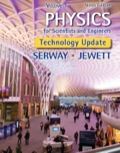
Concept explainers
A sidewalk is to be constructed around a swimming pool that measures (10.0 ± 0.1) m by (17.0 ± 0.1) m. If the sidewalk is to measure (1.00 ± 0.01) m wide by (9.0 ± 0.1) cm thick, what volume of concrete is needed and what is the approximate uncertainty of this volume?
The required volume of concrete and approximate uncertainty of the volume.
Answer to Problem 1.53P
The required volume of concrete is
Explanation of Solution
Given info: The length of swimming pool is
The length of the side walk in long side is,
The total length in small side is,
Formula to calculate the volume of rectangle in long side is,
Here,
Substitute
Thus, the volume of rectangle in long side is
Formula to calculate the volume of rectangle in small side is,
Substitute
Thus, the volume of rectangle in small side is
Write the expression for total volume of the concrete needed,
Substitute
Thus, the total volume of concrete required is
The uncertainty of the volume is the sum of uncertainty in each dimension.
The total length with uncertainty in the long side is,
The total length with uncertainty in small side is,
Formula to calculate the volume with uncertainty in long side is,
Here,
Substitute
Thus, the volume with uncertainty in long side is
Formula to calculate the volume with uncertainty in small side is,
Substitute
Thus, the volume with uncertainty in small side is
Write the expression for total volume with uncertainty,
Substitute
The total volume with uncertainty is
Write the expression for the uncertainty in the volume,
Substitute
Thus, the uncertainty in volume is
Conclusion:
Therefore, the required volume of concrete is
Want to see more full solutions like this?
Chapter 1 Solutions
EBK PHYSICS FOR SCIENTISTS AND ENGINEER
Additional Science Textbook Solutions
Human Biology: Concepts and Current Issues (8th Edition)
Campbell Biology: Concepts & Connections (9th Edition)
Cosmic Perspective Fundamentals
SEELEY'S ANATOMY+PHYSIOLOGY
Fundamentals of Physics Extended
Chemistry & Chemical Reactivity
- RT = 4.7E-30 18V IT = 2.3E-3A+ 12 38Ω ли 56Ω ли r5 27Ω ли r3 28Ω r4 > 75Ω r6 600 0.343V 75.8A Now figure out how much current in going through the r4 resistor. |4 = unit And then use that current to find the voltage drop across the r resistor. V4 = unitarrow_forward7 Find the volume inside the cone z² = x²+y², above the (x, y) plane, and between the spheres x²+y²+z² = 1 and x² + y²+z² = 4. Hint: use spherical polar coordinates.arrow_forwardганм Two long, straight wires are oriented perpendicular to the page, as shown in the figure(Figure 1). The current in one wire is I₁ = 3.0 A, pointing into the page, and the current in the other wire is 12 4.0 A, pointing out of the page. = Find the magnitude and direction of the net magnetic field at point P. Express your answer using two significant figures. VO ΜΕ ΑΣΦ ? Figure P 5.0 cm 5.0 cm ₁ = 3.0 A 12 = 4.0 A B: μΤ You have already submitted this answer. Enter a new answer. No credit lost. Try again. Submit Previous Answers Request Answer 1 of 1 Part B X Express your answer using two significant figures. ΜΕ ΑΣΦ 0 = 0 ? below the dashed line to the right P You have already submitted this answer. Enter a new answer. No credit lost. Try again.arrow_forward
 Principles of Physics: A Calculus-Based TextPhysicsISBN:9781133104261Author:Raymond A. Serway, John W. JewettPublisher:Cengage Learning
Principles of Physics: A Calculus-Based TextPhysicsISBN:9781133104261Author:Raymond A. Serway, John W. JewettPublisher:Cengage Learning Physics for Scientists and Engineers, Technology ...PhysicsISBN:9781305116399Author:Raymond A. Serway, John W. JewettPublisher:Cengage Learning
Physics for Scientists and Engineers, Technology ...PhysicsISBN:9781305116399Author:Raymond A. Serway, John W. JewettPublisher:Cengage Learning College PhysicsPhysicsISBN:9781938168000Author:Paul Peter Urone, Roger HinrichsPublisher:OpenStax College
College PhysicsPhysicsISBN:9781938168000Author:Paul Peter Urone, Roger HinrichsPublisher:OpenStax College University Physics Volume 1PhysicsISBN:9781938168277Author:William Moebs, Samuel J. Ling, Jeff SannyPublisher:OpenStax - Rice University
University Physics Volume 1PhysicsISBN:9781938168277Author:William Moebs, Samuel J. Ling, Jeff SannyPublisher:OpenStax - Rice University Physics for Scientists and Engineers: Foundations...PhysicsISBN:9781133939146Author:Katz, Debora M.Publisher:Cengage Learning
Physics for Scientists and Engineers: Foundations...PhysicsISBN:9781133939146Author:Katz, Debora M.Publisher:Cengage Learning College PhysicsPhysicsISBN:9781285737027Author:Raymond A. Serway, Chris VuillePublisher:Cengage Learning
College PhysicsPhysicsISBN:9781285737027Author:Raymond A. Serway, Chris VuillePublisher:Cengage Learning





